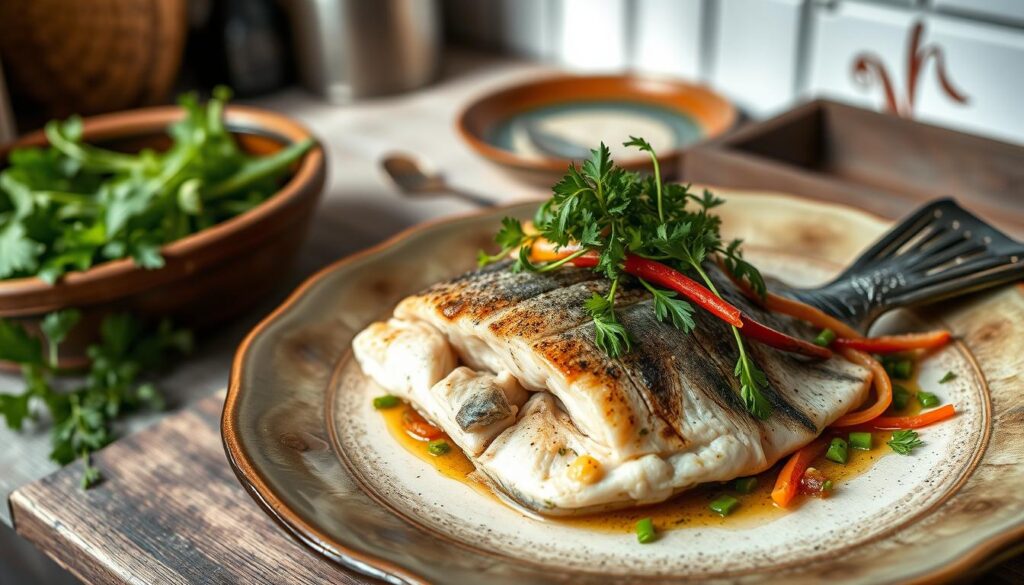Welcome to our exploration of the mother in law fish, a fascinating species known for its intriguing characteristics and culinary appeal. In this article, we will delve into what this fish is all about, its unique traits, and essential fish care tips to ensure its well-being. Readers can look forward to learning about mother in law fish nutritional value, including recipes that highlight its deliciousness through authentic mother in law fish recipes. By understanding its habitat, distribution, and care requirements, we aim to enhance our appreciation for this remarkable fish while also providing guidance on how to incorporate it into our meals.
What is Mother in Law Fish?
The mother in law fish encompasses a variety of species known for their culinary appeal and ecological significance. Often found in the Indo-Pacific region, they thrive in waters that extend from the eastern coast of Africa to Fiji, reaching as far north as Japan. These fish live at depths of up to 80 meters (260 feet) and can achieve a remarkable length of up to 100 centimeters (39 inches), with an average common length of about 55 centimeters (22 inches).
Known scientifically as cabeza fish, the term “mother in law fish” reflects a cultural significance and unique characteristics that make them a sought-after species. Fish identification of these species can be conducted by observing distinctive features such as body shape and coloration. Various types of mother in law fish populate different ecosystems, contributing to local biodiversity while also being impacted by fishing practices.
Our appreciation for the mother in law fish extends beyond its striking presence in marine habitats. Often caught using handlines or spear fishing, this fish is typically marketed fresh, making it a popular ingredient across various cuisines. Caution is advised, as these fish may contain ciguatoxin, leading to ciguatera poisoning in humans if consumed improperly. With their rich flavor profile, mother in law fish continues to be an important catch for both sustenance and commercial purposes.
Characteristics of Mother in Law Fish
The mother in law fish, commonly known as the Painted Sweetlips, displays a unique array of physical characteristics, notably in its coloration and body shape. This fish type captures the fascination of marine enthusiasts with its various hues and appearances across different species.
Physical Appearance
Adult mother in law fish typically exhibit a slate grey coloration, which provides effective camouflage in their natural habitats. Unlike the younger subadult fish, these adults lack the vibrant yellow or orange spots seen in some juvenile stages. This subtle color change emphasizes their maturity and ability to adapt to their environments.
Habitat and Distribution
We find the mother in law fish inhabiting diverse marine ecosystems, thriving particularly in warm waters. Their distribution is notably broad, extending across locations such as Queensland, Western Australia, and Lord Howe Island. Variations in habitat conditions, such as temperature and substrate, contribute to their growth and sustenance in these areas.

Different publications and marine guides reference this fish under various names, including Spilotichthys pictus, Diagramma labiosum, and Diagramma labiosus, particularly in Australian waters. The confusion surrounding their correct classification showcases the complexity of marine biodiversity, reinforcing the need for ongoing research in ichthyology. The mother in law fish remains a subject of interest in scientific studies, highlighting its characteristics and distribution across specific marine environments.
Why is it called Mother in Law Fish?
The name “mother in law fish” has captivated many due to its playful yet somewhat perplexing origins. This curious title evokes cultural references that often highlight humorous perceptions of in-laws. The común theory behind this naming suggests that the fish has a bland taste, leading to the notion that it is only fit for giving to one’s mother-in-law.
Exploring the mother in law fish origins provides fascinating insights into its etymology. Many cultures have their variations of the name, drawing from folklore, humorous anecdotes, or local preferences. For instance, this fish is also referred to as Slatey Bream, Blackall, Blubberlip, Morwong, and Painted Sweetlip in different regions. Each alias might have unique backstories, which adds layers to our understanding of this fish and its place within different communities.
Additionally, the naming of this fish reflects a broader cultural sentiment, illustrating how tastes can influence perceptions. Whether it’s the joy of fishing or the playful banter about family dynamics, the mother in law fish serves as an amusing reminder of how seafood can interlace with human experience.
| Aspect | Description |
|---|---|
| Average Size Caught | 62cm to 78cm |
| Maximum Recorded Weight | About 120kg |
| Common Locations | Myora, Peel, Hervey Bay, Tin Can, Wedge (Yeppoon) |
| Common Baits Used | TT lures, gulp craw, halco scorpion 150, plastic lures |
| Known Aliases | Slatey Bream, Blackall, Blubberlip, Morwong, Painted Sweetlip |
| Reason for Name | Bland taste, deemed suitable for giving to mother-in-law |
Fun Facts About Mother in Law Fish
We find mother in law fish to be fascinating creatures, both in their unique characteristics and their cultural importance. By exploring their unusual traits along with their significance in global cuisines, we uncover the intriguing world of this fish species.
Unique Traits
Mother in law fish possess various unique traits that distinguish them from other types of fish. Notably, they exhibit exceptional adaptability in their behavior and can thrive in a range of environments. Their vibrant colors and unique shapes make them a visual delight, drawing the curiosity of many fish enthusiasts. Other fun facts about mother in law fish include their territorial nature, which can lead to engaging interactions during feeding times.
Cultural Significance
The cultural significance of fish, particularly mother in law fish, spans numerous cuisines worldwide. In many cultures, these fish symbolize tradition and community, often featured in family gatherings and festive occasions. Their rich flavor adds depth to various dishes, making them a staple in many households. Understanding the cultural context of mother in law fish enhances our appreciation for this remarkable species.

| Region | Dishes Featuring Mother in Law Fish | Symbolic Meaning |
|---|---|---|
| Asia | Fish Curry | Family Unity |
| Caribbean | Grilled Fish with Tropical Salsa | Cultural Celebration |
| North America | Fish Tacos | Community Gatherings |
| Europe | Fish Stew | Heritage Preservation |
Mother in Law Fish Care
Caring for mother in law fish requires an understanding of their specific needs in various aspects of their environment. We will explore the essential components for a successful tank setup for fish, effective feeding guidelines, and optimal water conditions.
Choosing the Right Tank Setup
Creating the ideal tank setup for fish is crucial for maintaining the health of mother in law fish. Factors to consider include tank size, materials, and filtration systems. A tank of at least 50 gallons is preferable, allowing ample swimming space and reducing stress. Use aquarium-grade materials to ensure safety, and invest in a reliable filtration system to keep the water clean and clear.
Feeding Guidelines
Following appropriate fish feeding guidelines contributes significantly to the well-being of mother in law fish. Feed them high-quality pellets or flakes designed for adult fish, along with occasional treats like freeze-dried or frozen foods. It is essential to avoid overfeeding; offering small portions two to three times a day supports healthier growth and digestion.
Water Conditions
Establishing suitable water conditions for fish is key to ensuring the vitality of mother in law fish. Aim for a water temperature between 75°F and 80°F and maintain a pH level between 7.0 and 8.0. Regular water changes, approximately 10-15% each week, along with consistent monitoring of ammonia, nitrite, and nitrate levels, will promote a thriving aquatic environment.

Common Issues and Challenges in Caring for Mother in Law Fish
Taking care of mother in law fish can present various challenges in fish care that aquarists must address. By understanding potential health issues and behavioral concerns, we can ensure a thriving environment for these unique fish.
Health Problems
Mother in law fish health issues can arise from factors such as water quality, diet, and stress. Here are some common problems to monitor:
- Ich: A common parasite leading to white spots on the skin.
- Fin Rot: Caused by bacteria, resulting in frayed fins and lethargy.
- Swim Bladder Disease: Affecting buoyancy and swimming abilities.
- Velvet Disease: Exhibits a dust-like appearance on the skin.
Maintaining optimal water conditions and doing regular water changes helps minimize these health problems. Observing our fish carefully can help us catch signs of illness early.
Behavioral Concerns
Behavioral issues in fish may stem from environmental stressors such as overcrowding or aggression from tank mates. Here are some behaviors to watch for:
- Hiding: Indicating fear or stress in the fish.
- Aggression: Fighting or chasing other fish could signal territorial disputes.
- Erratic Swimming Patterns: May point to discomfort or illness.
Providing ample hiding spots and ensuring a properly balanced tank population can greatly reduce these behavioral issues in fish.
| Health Issue | Symptoms | Preventative Measures |
|---|---|---|
| Ich | White spots on skin | Maintain water temperature and quality |
| Fin Rot | Frayed fins, lethargy | Regular tank cleaning and water changes |
| Swim Bladder | Difficulty swimming | Balanced diet and proper feeding |
| Velvet Disease | Dust-like appearance | Maintain good water quality; quarantine new fish |
By recognizing and addressing mother in law fish health issues and behavioral concerns early on, we can contribute to their long-term health and vitality in our aquariums.
Best Mother in Law Fish Recipe
Our culinary journey highlights the best mother in law fish recipe, showcasing its versatility and rich flavors. This authentic recipe centers on the use of black cod, known for its tender, oily, and flaky texture. For those who prefer alternatives, ling cod, sea bass, or tilapia work beautifully too.

For this dish, we start with marinating the fish in a mixture that includes black beans, which are fermented soybeans. They impart a unique salty and funky flavor. A highly recommended option is “Yang Jiang Preserved Beans,” which is flavored with ginger for an extra zing.
The best mother in law fish recipe includes the following cooking steps:
- Marinate the fish for 30 minutes in the refrigerator.
- Prepare the steaming setup and steam the fish for 13-15 minutes until it reaches 145°F.
- Customize the sauce based on taste, adjusting with soy sauce or water as preferred.
This dish yields 2 servings, making it perfect for a small gathering. We can serve it alongside steamed rice or noodles, complemented by a crisp salad.
| Ingredient | Quantity | Notes |
|---|---|---|
| Black Cod | 2 filets or steaks | Choose thicker cuts for more moisture |
| Black Beans | 3 tablespoons | Use Chinese black beans for authenticity |
| Ginger (optional) | 1 teaspoon | Add to marinade for flavor |
| Soy Sauce | 2 tablespoons | Adjust based on your taste |
| Water | As needed | To adjust sauce consistency |
Incorporating these ingredients truly enhances our fish dishes, making the best mother in law fish recipe a remarkable addition to any dining experience.
How to Cook Mother in Law Fish
Cooking mother in law fish can be a rewarding experience, especially when we apply the right techniques and methods. Understanding how to cook mother in law fish sets the foundation for a delightful meal. First, consider some essential fish preparation tips to enhance the overall taste and presentation.
One excellent method involves slowly roasting the fish wrapped in foil with lemon juice and lemon pepper for about 20 minutes. This method helps to preserve moisture while infusing delicious flavors. Alternatively, grilling the fish on a BBQ with butter, salt, and garlic pepper creates a crispy, flavorful experience that many find appealing.
For those who prefer a more hands-on approach, we can fillet, skin, and bone the fish before shallow-frying it. Using a mixture of butter, lime juice, and sweet chili sauce adds a zesty twist that can elevate the dish significantly. It’s worth noting that regions where the fish is sourced can impact its flavor; some users have reported a strong iodine taste, which may detract from the overall dish. Quality sourcing can enhance satisfaction in our cooking endeavors.
We should keep in mind that experimenting with cooking methods for fish can yield great results. Options like marinating the fish overnight for curry dishes or roasting it with quartz stones not only show the fish’s versatility but can also open doors to delightful culinary experiences. Users have noted that when prepared well, this fish works beautifully in a Thai Green Fish Curry, showcasing its adaptable nature.
The importance of preparation cannot be overstated. Whether we are marinating, currying, or barbecuing, the methods we choose play a crucial role in enhancing the flavor of mother in law fish. Engaging with varied cooking techniques allows us to discover what resonates most with our taste buds, ensuring every meal is a memorable one.
Health Benefits of Mother in Law Fish
Understanding the health benefits of mother in law fish is essential for anyone considering its incorporation into their diet. This fish boasts several advantages due to its rich nutritional profile. The fish is an excellent source of protein, omega-3 fatty acids, and various vitamins. We can explore its nutritional value further to appreciate its contribution to a balanced diet.
Nutritional Value
The nutritional value of mother in law fish makes it a desirable choice for health-conscious eaters. Rich in essential fatty acids, particularly omega-3s, this fish supports brain function and development throughout life. It also provides various micronutrients like Vitamin D, Iron, and Zinc, which are crucial for overall health. Many studies endorse the inclusion of fish in our diets to promote better health outcomes, especially for pregnant women and children.
Potential Risks
Despite its numerous health benefits, we should be aware of the potential risks of eating mother in law fish. Contaminants found in fish, such as mercury, can pose health threats, especially for pregnant women. Awareness regarding these risks ensures that we make informed decisions about our fish consumption. By understanding both the advantages and risks associated with mother in law fish, we can enjoy its health benefits without compromising our well-being.
| Nutritional Component | Benefits | Risks |
|---|---|---|
| Omega-3 Fatty Acids | Supports brain health and reduces inflammation | Potential exposure to mercury |
| Proteins | Essential for muscle growth and repair | Allergic reactions in some individuals |
| Vitamins (D, A) | Supports immune function and bone health | Imbalance in diet if consumed excessively |
Conclusion
In summary, our exploration of the mother in law fish has provided us with a multifaceted understanding of this remarkable species. Through the discussions of its physical characteristics, habitat, and the cultural significance it holds, we have gained insight not only into fish care and cooking but also into its symbolic meanings in various narratives, such as found in literature.
Moreover, we should appreciate the health benefits of mother in law fish, which contribute to its culinary appeal. By integrating this fish into our diets or as an addition to our aquariums, we can enjoy both its taste and its vibrant presence, enriching our culinary experiences and home environments.
We encourage everyone to discover the versatility of the mother in law fish and to engage in responsible fish care and cooking practices. By embracing this journey, we can deepen our appreciation for the benefits of mother in law fish and the lessons it can teach us about life, loss, and culture.